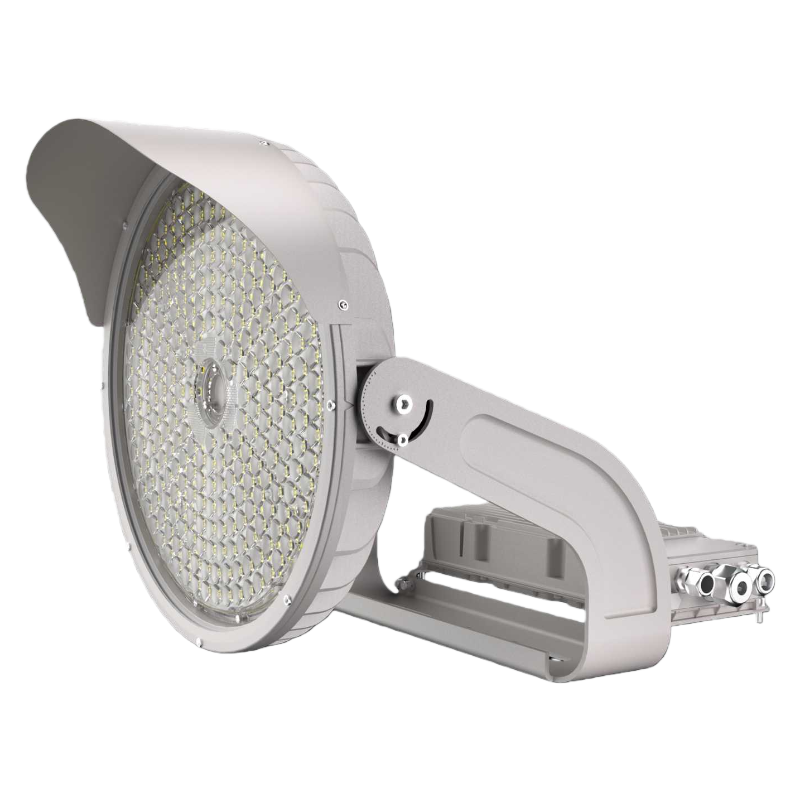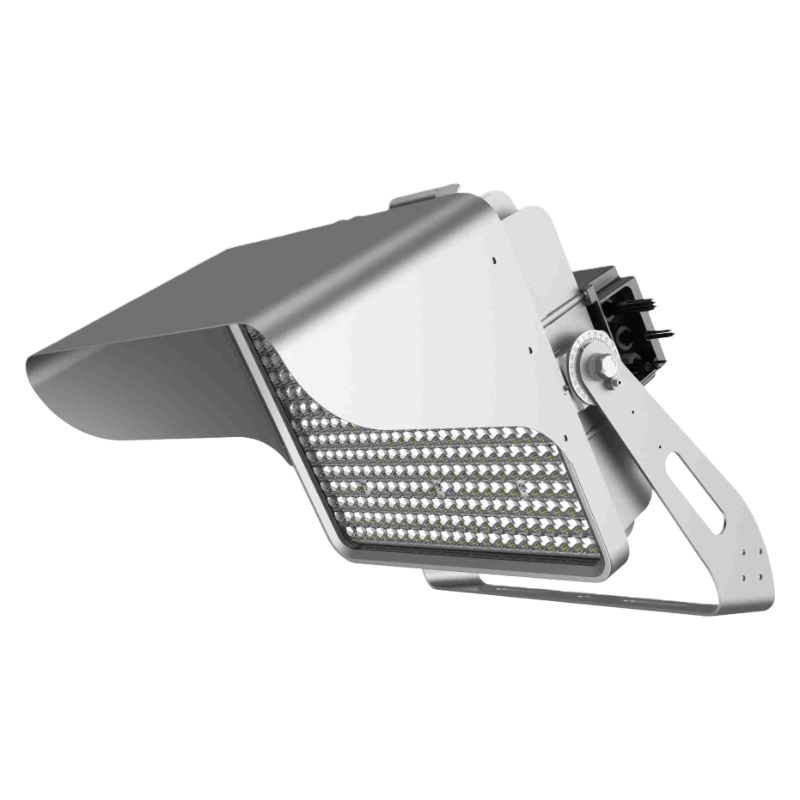Light Along the Wall: How LED Wall Lights Empower Wall-Mounted Sports Spaces
In urban spaces, between buildings, in community corners, and outside shopping malls, narrow spaces clinging to building walls are increasingly being transformed into sports areas. These include basketball courts nestled against office walls, badminton courts along residential walls, and fitness trails beneath shopping mall exteriors. These specialized venues, due to their proximity to the walls, are difficult to install with traditional ceiling-mounted fixtures. However, LED wall pack lights, thanks to their ability to be installed close to the wall, are becoming a lighting solution for these "wall-mounted sports spaces." This article will analyze the lighting challenges of wall-mounted sports spaces and how LED wall pack lights can meet these needs through innovative features.
I. The Lighting Dilemma of Wall-Mounted Sports Spaces: The Unique Challenges of Walls
Sports venues clinging to building walls, due to their unique spatial configuration, face distinct lighting challenges compared to open spaces:
Limited installation space: Overhanging eaves or pipelines may exist above the venue, making it difficult to install light poles; and the limited load-bearing capacity of the wall makes it difficult to install heavy fixtures. For example, the ping-pong table area next to a residential building's wall is only 20cm thick, and the mounting brackets for traditional lamps may exceed their load-bearing capacity.
Severe light obstruction: The wall itself blocks light, resulting in a "shadow band" on the side of the court closest to the wall. If the wall lamp is improperly installed, the wall's reflection can also create glare, affecting players' vision. For example, when a basketball court's sideline is close to the wall, players dribbling against the wall can be easily affected by light and shadow, making it difficult to judge the ball's landing point.
High environmental adaptability requirements: The wall may have problems draining rainwater, and the lamps must withstand rainwater running down the wall. Some venues (such as those outside shopping malls) also need to deal with condensation and dust accumulation at night, making conventional lamps susceptible to short circuits or light failure.
Limited lighting range: These venues are often long and narrow (e.g., 3-5 meters wide and 10-20 meters long). The fixed beam angle of traditional wall lamps makes it difficult to achieve uniform coverage, resulting in "too bright near the end and too dim far away" effects.
II. LED Wall Lights for Sports Lighting: Targeted Solutions to Wall-Side Problems
Designed specifically for wall installation, LED wall lights are perfectly suited to wall-mounted sports spaces through optimized structure and optics. Their core features are reflected in four dimensions:
1. Optical Design: Light distribution tailored to narrow and long spaces
Optimized directional beam angle: Utilizing an asymmetric optical lens, this light distribution achieves a 60° × 120° rectangular beam distribution (120° horizontally covers the width of the court, and 60° vertically focuses on the depth). For example, an LED wall light installed on a 3-meter-high wall can create a uniform illumination strip 5 meters wide and 15 meters long on the ground, precisely covering half of a basketball court against the wall.
Stepped illumination control: Single lamp power is adjustable from 20W to 100W, with a luminous flux of 2,000lm to 12,000lm. Multiple lamps can be combined to create gradient lighting. For example, installing a 30W wall light every 5 meters on a fitness trail can maintain a ground illumination of 50-80 lux with a uniformity of ≥0.7, preventing alternating bright and dark areas.
Anti-Glare and Reflection Control: The light outlet utilizes a frosted lens with a 15° downward tilt, keeping the glare value (UGR) below 25 while also reducing reflections from direct light hitting the wall. In badminton court applications, this can increase the brightness contrast between the ball and the background by 40%, making it easier to discern the ball's spin.
2. Structure and Protection: Adaptable to Complex Wall Environments
Ultra-thin and Lightweight Design: The luminaire is ≤15cm thick and weighs ≤3kg. It uses a wall-mounted clip-on installation method that secures with a single expansion screw and is compatible with most wall loads (≥5kg/point). It can be safely installed even on lightweight partition walls such as community walls.
Superior Waterproof and Dustproof: IP66 protection rating with drip-proof design. Drain holes are provided on the back of the luminaire to protect against rainwater running down the wall. The sealing ring is made of age-resistant silicone and maintains a seal in temperatures ranging from -30°C to 60°C, suitable for outdoor locations with large temperature swings between day and night.
Corrosion and Impact Resistance: The die-cast aluminum housing is electrophoretically treated to resist rusting in humid environments. The polycarbonate protective cover achieves an IK08 impact rating, allowing it to withstand accidental impacts from equipment such as basketballs and badminton rackets.
3. Intelligent Functions: Adapting to Dynamic Usage Scenarios
Human Activity Sensor: Built-in infrared and microwave dual-mode sensors offer a detection range of up to 8m x 10m. It automatically illuminates (at 100% brightness) when human activity is detected, reducing brightness to 30% after 3 minutes. This makes it ideal for community venues with fluctuating usage, achieving energy savings of over 60%. Time-sharing Lighting Mode: Supports programmable time control, such as full brightness from 6:00 PM to 10:00 PM on weekdays (suitable for peak after-get off work exercise), and 30% brightness during the rest of the day. Full brightness is automatically extended to 11:00 PM on weekends to accommodate leisure and exercise habits.
Automatic Fault Warning: Using the LoRa wireless communication module, operating status is uploaded to the management platform in real time. When a lamp experiences voltage anomalies or brightness decreases by more than 20%, a maintenance alert is automatically sent, preventing blind spots caused by single lamp failures.
4. Installation and Adaptation: A flexible solution for zero-modification wall installations
Multi-angle Adjustable Bracket: The luminaire can rotate ±30° horizontally and tilt ±20° vertically, allowing fine-tuning of the illumination angle during installation to suit the site's shape. For example, on a trapezoidal wall, angle adjustment can compensate for variations in illumination caused by varying widths. Wide Voltage Compatibility: Supports AC100-277V input, adapting to diverse power grid environments, such as residential communities and shopping malls. An optional DC24V safety voltage version reduces the risk of electric shock when used in children's play areas (such as a small soccer field next to graffiti).
Plug-and-Play Design: Standardized wiring terminals are included, eliminating the need to modify the wall circuitry and allowing direct replacement of existing wall lamps. Installation time is reduced by 50% compared to installing new fixtures, without disrupting the venue's operation.
III. Scenario Implementation: LED Wall Light Solution for Wall-Based Sports Spaces
Office Building Wall Basketball Court (Half-width, 200㎡): Six 80W LED wall lamps were installed on four walls, with a beam angle of 60° x 120°, a mounting height of 3.5 meters, and a downward tilt of 15°. The average illumination on the court reaches 250 lux, with illumination near the walls remaining above 200 lux. The uniformity is 0.72, meeting the requirements for 3v3 amateur competitions.
Community wall badminton area (60 m2): 50W wall sconces are installed every 5 meters along the 20-meter-long wall, using asymmetric light distribution to ensure illumination of ≥300 lux around the net. Using motion sensing, power consumption is reduced to 15W when unoccupied, saving approximately 800 kWh of electricity annually.
Shopping mall exterior fitness trail (100 m long): 30W wall sconces are installed every 8 meters along the mall's exterior wall. The beam angle is 90° x 150°, creating a 1.5-meter-wide illuminated strip on the ground with an average illumination of 60 lux. Combined with light-sensing control, the sconces automatically illuminate in the evening and dim to 50% after midnight, ensuring both safety and energy efficiency.
The use of LED wall lights in wall-mounted sports spaces redefines the lighting logic of "leftover spaces"—instead of relying on additional light poles, they transform building walls into lighting platforms, achieving efficient illumination with minimal space usage. With urban sports space becoming increasingly limited, this "wall-based lighting" model revitalizes unused areas like building gaps and perimeter walls for sports. When LED wall lights illuminate the sports field beneath the wall at dusk, they illuminate more than just a field; they also demonstrate a smart way for cities to utilize fragmented spaces to promote fitness for all.











